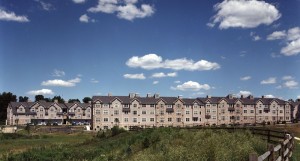 Clemson’s SCE&G Energy Innovation Center Rated LEED Gold Certified CLEMSON – Clemson University’s South Carolina Electric and Gas (SCE&G) Energy Innovation Center at the Restoration Institute in North Charleston has been awarded LEED Gold certification by the U.S. Green Building Council. The Leadership in Energy and Environmental Design (LEED) certification accredits buildings that meet rigorous standards for sustainability, water and energy efficiency, resource selection and indoor environmental quality. The center houses the world’s most-advanced wind-turbine drivetrain testing facility and the Duke Energy eGRID (Electrical Grid Research Innovation and Development). The combined facility is capable of full-scale highly accelerated mechanical and electrical testing of advanced drivetrain systems for wind turbines and other multi-megawatt devices, such as those for energy-storage, photovoltaic smart inverters, distributed generators, micro-grids and smart grid technology. “This rating has been accomplished through a diligent effort by all the involved project staff and contractors,” said Nick Rigas, SCE&G Energy Innovation Center director. “Given the facility is an industrial-grade center and the site was a brownfield, there were many concerns as to how to even achieve the silver rating required by the university.” Engineering design was performed by AEC Engineering in Minneapolis, and Choate Construction of Mount Pleasant provided construction management services. Design of the facility had to take into account poor soil conditions, seismic considerations, hurricane resistance and many other factors that come with the design and construction of a one-of-a-kind facility. Advanced technology designed into the facility will recover 75 to 80 percent of the 22.5 megawatts of electricity needed to operate the test dynamometers. “We are very pleased and proud that the Clemson SCE&G Energy Innovation Center has achieved LEED Gold status,” said Thomas Lorentz Sr., vice president of AEC Engineering. “It is a fitting tribute to the project team that this unique, world-class energy research facility be recognized as having successfully integrated sustainability and efficiency in the design and construction process.” More than 50 percent of the existing building materials, including concrete, cladding and structural steel were reused. This re-use included the repurposing or remanufacture of structural steel elements into new uses for the materials with an end result that more than 75 percent of what might have been construction debris was recycled. Environmental concerns were further addressed by enhancing the facility’s indoor air quality by using low-emission admitting compounds for paints, flooring wood and agricultural fiber projects. Airflow monitoring systems and occupancy sensors for lighting will provide for greater energy efficiency. “With each new LEED-certified building, we get one step closer to the U.S. Green Building Council’s vision of a sustainable built environment within a generation,” said Sara O’Mara, LEED Fellow and director of LEED/Environmental Services for Choate Construction Co. “As the newest member of the LEED family of green buildings, Clemson’s SCE&G Energy Innovation Center is an important addition to the growing strength of the green building movement.”
Clemson’s SCE&G Energy Innovation Center Rated LEED Gold Certified CLEMSON – Clemson University’s South Carolina Electric and Gas (SCE&G) Energy Innovation Center at the Restoration Institute in North Charleston has been awarded LEED Gold certification by the U.S. Green Building Council. The Leadership in Energy and Environmental Design (LEED) certification accredits buildings that meet rigorous standards for sustainability, water and energy efficiency, resource selection and indoor environmental quality. The center houses the world’s most-advanced wind-turbine drivetrain testing facility and the Duke Energy eGRID (Electrical Grid Research Innovation and Development). The combined facility is capable of full-scale highly accelerated mechanical and electrical testing of advanced drivetrain systems for wind turbines and other multi-megawatt devices, such as those for energy-storage, photovoltaic smart inverters, distributed generators, micro-grids and smart grid technology. “This rating has been accomplished through a diligent effort by all the involved project staff and contractors,” said Nick Rigas, SCE&G Energy Innovation Center director. “Given the facility is an industrial-grade center and the site was a brownfield, there were many concerns as to how to even achieve the silver rating required by the university.” Engineering design was performed by AEC Engineering in Minneapolis, and Choate Construction of Mount Pleasant provided construction management services. Design of the facility had to take into account poor soil conditions, seismic considerations, hurricane resistance and many other factors that come with the design and construction of a one-of-a-kind facility. Advanced technology designed into the facility will recover 75 to 80 percent of the 22.5 megawatts of electricity needed to operate the test dynamometers. “We are very pleased and proud that the Clemson SCE&G Energy Innovation Center has achieved LEED Gold status,” said Thomas Lorentz Sr., vice president of AEC Engineering. “It is a fitting tribute to the project team that this unique, world-class energy research facility be recognized as having successfully integrated sustainability and efficiency in the design and construction process.” More than 50 percent of the existing building materials, including concrete, cladding and structural steel were reused. This re-use included the repurposing or remanufacture of structural steel elements into new uses for the materials with an end result that more than 75 percent of what might have been construction debris was recycled. Environmental concerns were further addressed by enhancing the facility’s indoor air quality by using low-emission admitting compounds for paints, flooring wood and agricultural fiber projects. Airflow monitoring systems and occupancy sensors for lighting will provide for greater energy efficiency. “With each new LEED-certified building, we get one step closer to the U.S. Green Building Council’s vision of a sustainable built environment within a generation,” said Sara O’Mara, LEED Fellow and director of LEED/Environmental Services for Choate Construction Co. “As the newest member of the LEED family of green buildings, Clemson’s SCE&G Energy Innovation Center is an important addition to the growing strength of the green building movement.”
Choate Construction Project, SCE&G Energy Innovation at Clemson, Rated LEED Gold
December 2014
